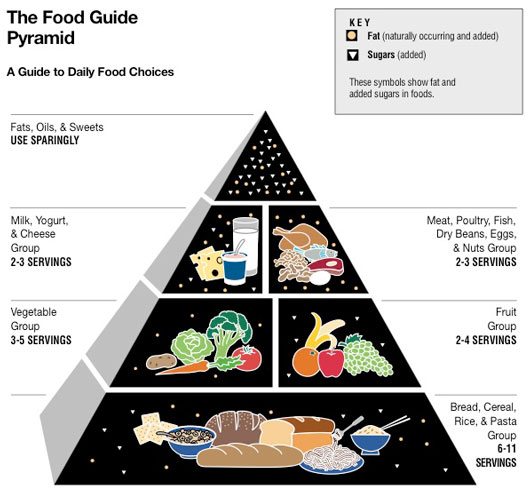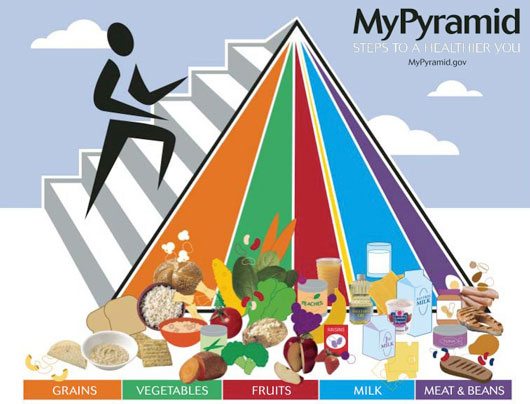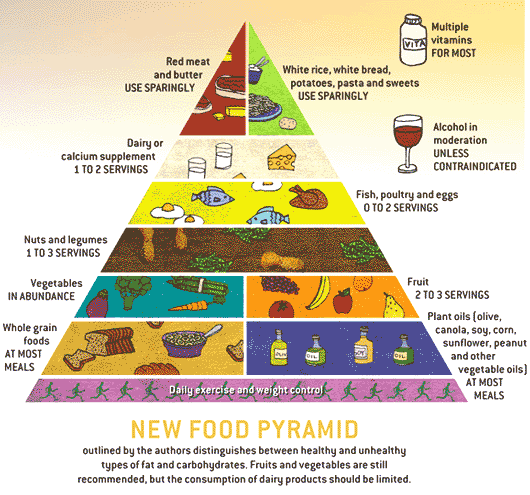Rebuilding the Food Pyramid
Originally written in 2004 as a handout for patients. Updated 2009 & 2024.
Willett & Stampfer, January 1 2003 (History, Science)
For more than ten years the U.S. Department of Agriculture has promoted its food pyramid as a guide to proper nutrition. The only problem is that it isn't very good advice! The authors of this January 2003 article in Scientific American provide much better guidance. But first a little history…

At the most basic level the the old pyramid favored carbohydrates over fat. But not all fat is bad, and the assumption that carbs are a good replacement is flawed. The pyramid has 'bread, cereal, rice, & pasta' as it's foundation, with 6-11 servings per day. But relying on these carbohydrate rich foods is not always a good thing. Fats and oils are at the top and should be used sparingly
if at all, in spite of evidence that certain fats are actually beneficial.
New and Improved?
In 2005 the USDA revised the pyramid and made matters worse. The ambiguous, vertical stripes convey no useful information. The pyramid shape remains only to provide a slope for the stick figure to climb! Digging deeper, the supporting information on the site is not bad, but remains flawed in subtle ways that I will enumerate below.

Research has shown that there are 'good' and 'bad' fats. Good fats are found in fruits, grains, and their oils. Olive, canola, and corn oil are good examples. On the other hand, saturated and trans fats are bad. Red meat, certain seafood and butter contain lots of saturated fat. Trans fats are a man-made problem. They are manufactured from oils to be more solid at room temperature—in margarine for example. If a food label says the product contains 'hydrogenated' or 'hardened' oils, you are likely dealing with trans fat. It turns out these are the worst of all, increasing 'bad' LDL and decreasing 'good' HDL cholesterol. High LDL and low HDL may lead to heart disease and other problems.
A word of caution about food labels…No Trans Fatcan be a deceptive phrase. Products that contain less than a certain threshold are labeled zero trans fat. The key factor is portion size, which is not standardized and may be unreasonably small when compared with what people actually eat. (When was the last time you counted out twelve potato chips?!) So many popular processed foods have significant amounts of trans fat even though their labels claim they they are trans fat free. You have to read between the lines!
Carbohydrates are seen as the good guys in the traditional pyramid. There are two problems with this. When carbos replace foods rich in 'good' fats—such as olives or olive oil—LDL goes up, HDL goes down, and heart disease may be on the way. Eating too much of the wrong kinds of carbohydrate may also contribute to diabetes. Remember our list of 'bread, cereal, rice, & pasta'? It turns out that white bread, refined cereal, white rice, and pasta all contain large amounts of starch, which is a form of sugar. They can quickly become bad when you eat too much of them. Potatoes also fall into this category. The missing ingredient is fiber. Whole grains have more fiber and less starch and are therefor healther. Examples include whole wheat bread and brown rice.
A Better Pyramid
So what's to be done? Researchers at the Harvard School of Public Health have suggested an alternative pyramid to help us make better choices about food. Here is a summary of their recommendations:
- A foundation of whole grain foods and plant oils are eaten at most meals
Vegetables in abundance
at every meal- Two or three servings of fruit every day
- Protein from nuts, beans, fish, poultry, and eggs
- One or two servings of dairy products per day
- Red meat, butter, white rice, white bread, potatoes, and sweets should all be
used sparingly
- No trans fats at all if you can avoid them
- Finally, they recommend daily exercise and weight control, always a good idea!

Notice these important differences with the USDA pyramid
…
- Plant oils at every meal
- Lower limit on dairy foods
- Nuts and legumes are separated from meat
- Potatoes are not grouped with vegetables
- Explicit, use-sparingly
white
food group, including potatoes[4] - Butter is included in the use-sparingly meat group
This is the pyramid that the USDA should have published, but didn't!
References
- [1] Rebuilding the Food Pyramid, Walter C. Willett and Meir J. Stampfer, https://www.scientificamerican.com/article/rebuilding-the-food-pyram/, Accessed January 2003
- [2] PDF of the Original Article, http://harenberg.weebly.com/uploads/4/7/5/4/47544635/rebuilding_the_food_pyramid__jstor_.pdf, Accessed December 2024
- [3] MyPyramid.gov, U. S. Department of Agriculture, http://www.mypyramid.gov, Accessed December 2005, Now https://www.myplate.gov, Accessed December 2024
- [4] Potatoes appear to be a special case, with type and preparation being very important. This ranges from best (a baked sweet potato) to worst (french fries or chips fried in animal fat).